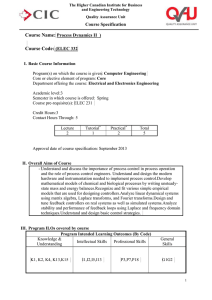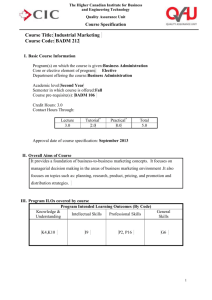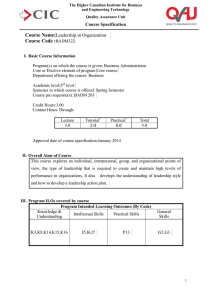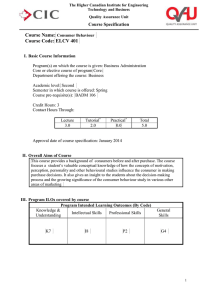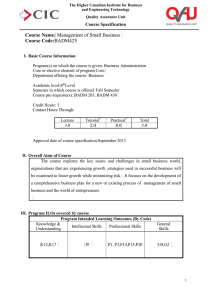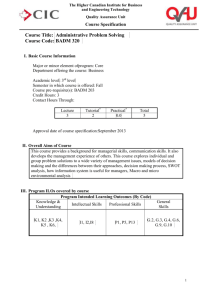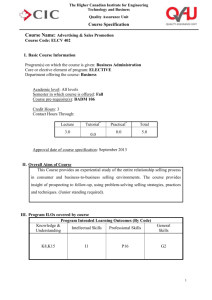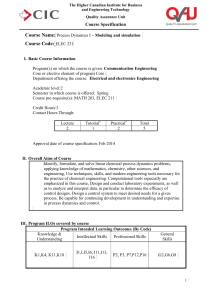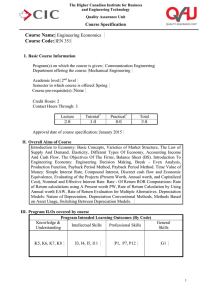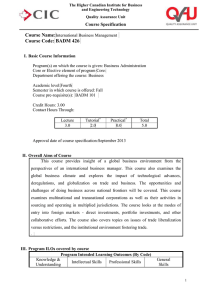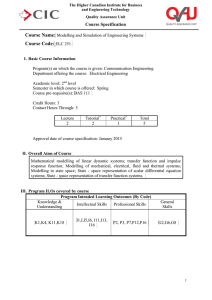COURSE TITLE (COURSE CODE)
advertisement
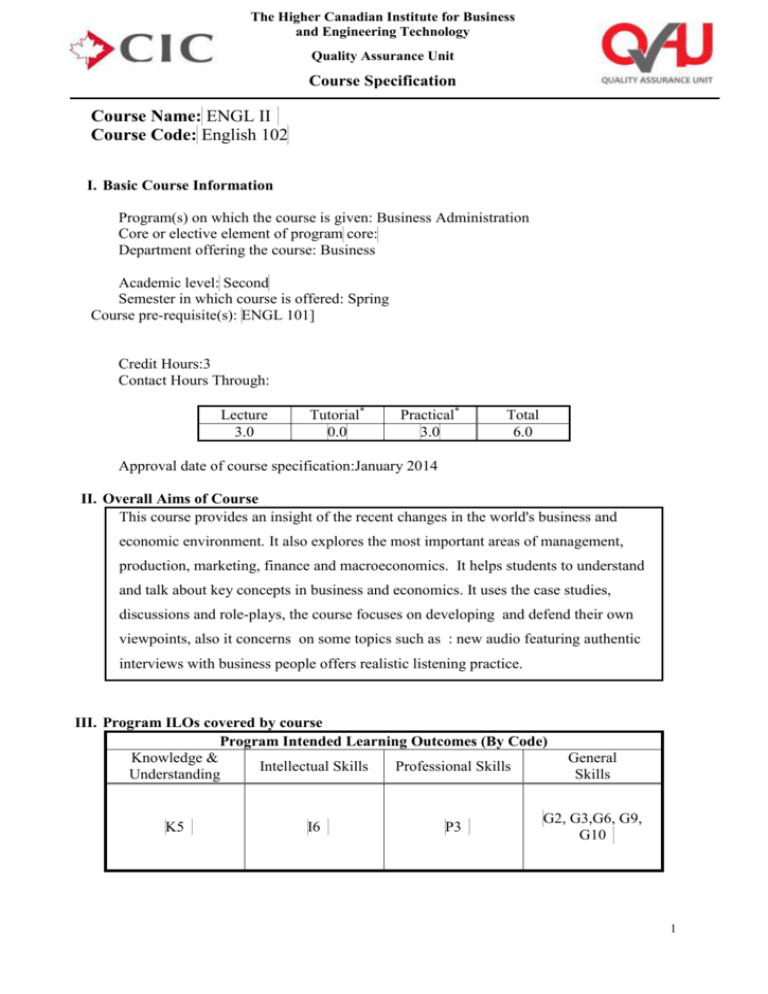
The Higher Canadian Institute for Business and Engineering Technology Quality Assurance Unit Course Specification Course Name: ENGL II Course Code: English 102 I. Basic Course Information Program(s) on which the course is given: Business Administration Core or elective element of program core: Department offering the course: Business Academic level: Second Semester in which course is offered: Spring Course pre-requisite(s): ENGL 101] Credit Hours:3 Contact Hours Through: Lecture 3.0 Tutorial* 0.0 Practical* 3.0 Total 6.0 Approval date of course specification:January 2014 II. Overall Aims of Course This course provides an insight of the recent changes in the world's business and economic environment. It also explores the most important areas of management, production, marketing, finance and macroeconomics. It helps students to understand and talk about key concepts in business and economics. It uses the case studies, discussions and role-plays, the course focuses on developing and defend their own viewpoints, also it concerns on some topics such as : new audio featuring authentic interviews with business people offers realistic listening practice. III. Program ILOs covered by course Program Intended Learning Outcomes (By Code) Knowledge & Intellectual Skills Professional Skills Understanding K5 I6 P3 General Skills G2, G3,G6, G9, G10 1 The Higher Canadian Institute for Business and Engineering Technology Quality Assurance Unit Course Specification IV. Intended Learning Outcomes of Course (ILOs) a. Knowledge and Understanding Upon completion of the course, students should be able to: K.1locate key information in complex sentences K.2Identify topic development within a paragraph K.3 Recognize different essay types/ structures K.4 Infer implicit ideas b. Intellectual/Cognitive Skills Upon completion of the course, students should be able to: I.1 Create topic sentences I.2 Compose compound and complex sentences I.3 Construct essay outlines I.4 Compose different types of essays I.5 Generate effective introductions/conclusions c. Practical/Professional Skills Upon completion of the course, students should be able to: P.1 Use different reading skills P.2 Utilize vocabulary as a key ingredient in developing advanced written skills P.3 Compose better grammatical sentences that help them write better essays d. General and Transferable Skills Upon completion of the course, students should be able to: G.1Develop comprehension of business and economics texts G.2 Develop listening and speaking skills in the fields of business and economics G.3 Conclude business concepts both verbally and in writing, while summarizing, analyzing, criticizing and discussing ideas. G.4Simulate appropriate written and oral communication in professional situations in English. G.5 Comply with the expectations of professional linguistic behavior in English speaking business environments with regards to formal communication, politeness, developing relations, and socializing. V. Course Matrix Contents Main Topics / Chapters 12345- The business of business The organization of work The business of business The organization of work Getting the work done The world of technology Getting the work done The world of technology People and markets Products and strategies Duration (Weeks) Course ILOs Covered by Topic (By ILO Code) K&U I.S. P.S. G.S. 1 G1, G2 1 G1, G2, G3 I1 1 K2 P1, P2 G3 1 K2 P1, P2 G4 1 K1 I2 G3 2 The Higher Canadian Institute for Business and Engineering Technology Quality Assurance Unit Course Specification People and markets 6- Products and strategies 1 K1 I2 1 K3 I3 P3 G4 1 K3 I4 P3 G5 Managing financial accounts 9- Funding company activities 1 K4 Managing financial accounts 10- Funding company activities 1 K4 I5 P3 G5 1 K3 I5 P3 Operations: producing the goods 7Operations: efficiency, costs and quality Operations: producing the goods 8- Operations: efficiency, costs and quality External influences Marketing External influences 12Marketing Net Teaching Weeks 11- 1 I5 12 VI. Course Weekly Detailed Topics / hours / ILOs Week No. 1 2 3 4 5 6 7 8 9 10 11 12 13 Sub-Topics Types of business The history of business How organizations are structured Leadership and teams Productivity Theories of motivation Management by objectives Computers for research Technological change Marketing Total Hours Contact Hours Theoretical Practical Hours Hours* 6 6 6 3 3 6 3 3 6 3 3 6 Midterm Exam The role of the product 6 The production process 6 Operations management 6 Accounting 6 Business Finance 6 External influences on business 6 Company performance: SWOT analysis 6 3 3 3 3 3 3 3 3 3 3 3 3 3 3 3 3 3 The Higher Canadian Institute for Business and Engineering Technology Quality Assurance Unit Course Specification 14 Total Teaching Hours Final Exam 72 39 33 VII. Teaching and Learning Methods Teaching/Learning Method Lectures & Seminars Tutorials Computer lab Sessions Practical lab Work Reading Materials Web-site Searches Research & Reporting Problem Solving / Problem-based Learning Projects Independent Work Group Work Case Studies Presentations Simulation Analysis Course ILOs Covered by Method (By ILO Code) K&U ALL Intellectual Skills ALL Professional Skills ALL General Skills ALL K4 G1 P1, P2 Others (Specify): VIII. Assessment Methods, Schedule and Grade Distribution Course ILOs Covered by Method (By ILO Code) Assessment Method K&U I.S. P.S. G.S. Midterm Exam Final Exam Quizzes Course Work Report Writing Case Study Analysis Oral Presentations Practical Group Project Individual Project Others (Specify): K1, K3 I1, I2, I3 ALL K4 ALL I3,I4, I5 G1, G2. G3, G4 ALL ALL G5 Assessment Weight / Percentage Week No. 20% 7 50% 10% 20% 14 6, 12 3, 10 4 The Higher Canadian Institute for Business and Engineering Technology Quality Assurance Unit Course Specification IX. List of References Required Text Books Course notes Recommended books Periodicals, Web sites, etc … Walker, Carolyn. English for Business Studies.2010. X. Facilities required for teaching and learning List the facilities required: white board Projector Flashcards Regalia Course coordinator: Dr. Noha El-Torky Head of Department: Dr. Dina Kreema Date: January 2014 5
